|
Research Catalog
A comprehensive manual of natural and cultural study opportunities within Mount Rainier, North Cascades, and Olympic National Parks |

|
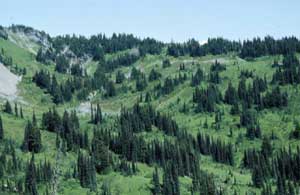 |
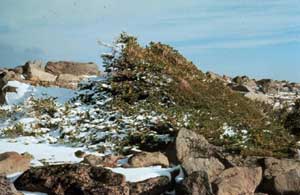 |
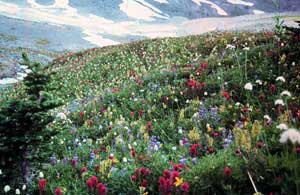 |
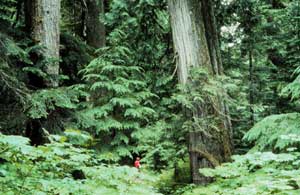 |
Plant Ecology
Inventory Non-vascular Plant Species
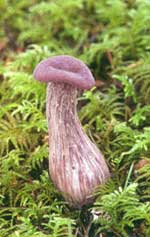 photo credit: Robert Morgan |
Background
Non-vascular plants species (mosses, lichens, liverworts, and fungi) are
a poorly known component of parks in the Pacific Northwest, despite
their ecological and aesthetic importance. They comprise a significant
portion of the biomass and annual production in temperate rainforests
(Vitt et al., 1988), and are known to play important ecological roles in
hydrologic (Norris, 1990, Boucher and Nash, 1990) and nutrient cycling
(Nadkarni, 1983). They are also known to be sensitive to precipitation
chemistry and air quality (Hawksworth and Hill, 1984). Populations of
some non-vascular plants may be at risk due to illegal harvest by
commercial interests. Protection of these species would be more
effective if their abundance and distribution was well understood. As a
result of their ecological importance, their sensitivity to air
pollution, their inclusion in the Forest Plan, and the attraction they
hold for illegal harvest, non-vascular plants are crucial components in
the long-term ecological monitoring program currently under development
in the parks. However, prior to identifying key species for long-term
monitoring and the development of monitoring protocols, parks need a
better inventory of non-vascular plants and estimates of their
abundance. Although Olympic National Park has recently initiated
surveys on mosses, lichens, and liverworts, surveys are still needed to
expand knowledge on the occurrence and distribution of fungi. North
Cascades National Park has recently developed a photographic inventory
of fungi that includes 97 species. Mount Rainier National Park has a
limited herbarium collection that includes about 1300 specimens of
fungi, mosses, and lichens. Development of species lists, surveys of
abundance and distribution, and identification of key species for future
research and long-term monitoring is needed for each park.
Park Focus: MORA, NOCA, OLYM
Research Needs
Species inventories, collection of specimens for park herbariums, and
distribution surveys of mosses, lichens, and liverworts in North
Cascades and Mount Rainier National Parks.
Species inventories, collection of specimens for park herbariums, and distribution surveys of fungi and North Cascades, Mount Rainier, and Olympic National Parks.
Identification of key species for long-term monitoring of plant communities is needed.
References Cited
Boucher, V. L. and T. H. Nash III. 1990. The role of the fruticose
lichen Ramalina menziesii in the annual turnover of biomass and
macronutrients in a blue oak woodland. Botanical Gazette (Chicago)
151:114-118.
Hawksworth, D. L. and D. J. Hill. 1984. The Lichen Forming Fungi. Chapman and Hill, New York.
Nadkarni, N. M. 1983. The effects of epiphytes on nutrient cycles within temperate and tropical rainforest tree canopies. Ph.D. Dissertation, University of Washington, Seattle.
Norris, D. H. 1990. Bryophytes in perennially moist forests of Papua New Guinea: Ecological orientation and predictions of disturbance effects. Botanical journal of the Linnean Society 104:281-291.
USDA and USDI. 1994. Record of Decision for Amendments to Forest Service and Bureau of Land Management Planning Documents within the Range of the Northern Spotted Owl. U.S. Printing Office, Washington, D.C.
Vitt, D. H., J. E. Marsh, and R. B. Bovey. 1988. Mosses, Lichens, and Ferns of Northwest North America. Lone Pine Publishing, Vancouver, B.C.
Rev. 9/2000
Whitebark pine (Pinus albicaulis)
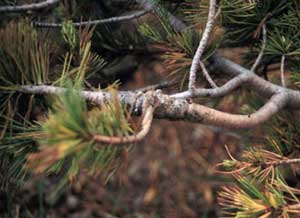
Background
Whitebark pine is an important component of high-elevation ecosystems in
the Pacific Northwest. It is a pioneer species on exposed sites with
harsh climates and environmental conditions. Its establishment modifies
the microclimate on these sites, enabling other species such as
subalpine fir (Abies lasiocarpa) to gradually establish in these
areas. On a landscape level, its presence affects snow accumulation,
retention and drainage patterns. The species is also an important food
source for nutcrackers, grizzly bears, red squirrels, and several small
mammals. The introduction of blister rust (Cronartium ribicola)
from Eurasia in 1921 has severely threatened the long-term survival of
white pines native to North America (Hadfield, 2000). By 1946, the
susceptibility of white pines to this disease and its rate of spread
were evident. Currently, there is only limited data available on the
status of whitebark pine stands in the Pacific Northwest (Rochefort,
1995, Hadfield et al. 1996) and fewer studies on population processes
within this ecosystem (Jorgensen, 1996, DelPrato, 1999). Most studies
have been conducted in the Rocky Mountains where population processes
and climates may be significantly different.
The National Park Service strives to protect naturally functioning ecosystems and their processes. In the case of whitebark pine, research is needed to better understand natural processes and the influence of blister rust on Cascade populations in order to develop long-term monitoring programs and management strategies.
Park Focus: MORA, NOCA
Research Needs
What is the role of fire in whitebark pine ecosystems of the Cascades?
Is this role different in the drier east-slope habitats of North
Cascades National Park Service Complex than in Mount Rainier National
Park?
What is the demographic structure of whitebark pine populations? What is the status of regeneration in these stands?
What is the genetic diversity of populations in the Cascades and how do these differ from those of populations in Rocky Mountains or Sierra Nevada? What management application does this information have?
Available Resources
Mount Rainier National Park: digitized maps of whitebark pine stands as
of 1935, preliminary survey data of 19 of the 69 stands
North Cascades National Park: survey data of 6 stands will be available after the 2000 field season
References Cited
DelPrato, P.D. 1999. Effect of blister rust on whitebark pine in Mt.
Rainier National Park, WA. M.S. Thesis, St Joseph's University,
Philadelphia, PA.
Jorgensen. S.M. 1996. Biogeography and population genetics of whitebark pine, Pinus albicaulis Engelm. M.S. thesis, University of Georgia, Athens, GA.
Hadfield, J., P. Flanagan, and A. Camp. 1996. White pine mortality survey in the eastern Washington Cascade range. Nutcracker Notes 7:8.
Hadfield, J. 2000. History of white pine blister rust on whitebark pine in the Pacific Northwest. USDA. USFS. Pacific Northwest Region, Forestry Sciences Lab, Wenatchee Service Center, 11p.
Rochefort, R. 1995. Whitebark pine blister rust survey, Mount Rainier National Park, 1994. Nutcracker Notes 6: 3-4.
Rev. 9/2000
Cryptobiotic Soil Crusts
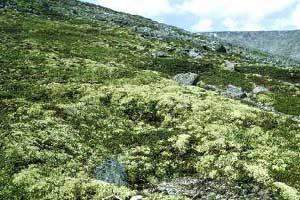 photo credit: Warren G. Gold 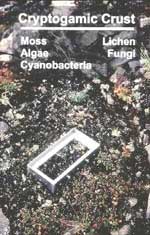
|
Background
Cryptobiotic soil crusts are an important feature of high-elevation
ecosystems of the Pacific Northwest. Preliminary surveys have documented
their occurrence across a wide variety of habitats and soil moisture
regimes. In Mount Rainier National Park, they have been observed in
east-side Festuca viridula communities, alpine heather
communities, and alpine fellfield communities. Observations in the
Olympic Mountains have documented their occurrence in graminoid meadows,
Salix artica or Empetrum nigrum dominated solifluction
lobes and Carex nigricans dominated late snowbed communities.
Species composition also changes significantly across these habitats,
but there are few studies that describe these associations. Research in
desert and tundra ecosystems has shown that these crusts increase
rainfall infiltration, reduce sediment production and runoff, and
facilitate establishment of vascular plants through enhancing nutrient
and water availability for these plants. In Arches National Park, crust
condition is used as an indicator of ecosystem health (integrity)
because crust condition is easily measured and has high ecological
relevance (Belnap, 1998). Research demonstrated that visitor trampling
of cryptobiotic soils, can significantly decrease nutrient cycling and
alter successional patterns. Similarly, research on cryptobiotic crusts
may have important management implications in Wilderness areas of
Pacific Northwest Parks.
Park Focus: MORA, NOCA, OLYM
Research Needs
Baseline inventories and descriptions of cryptobiotic crusts are needed.
These inventories should include identify species compositions,
geographic and environmental distribution of crusts, and condition of
crusts.
What are the influences of cryptobiotic crusts on nutrient cycling, soil temperature, and water availability in alpine areas?
What is the role of cryptobiotic crusts in the population dynmaics and establishment of vascular plants in alpine areas? How can this information be applied to assist in high elevation restoration efforts?
What effects do cryptobiotic crusts have on plant species composition and primary productivity of high elevation communities? Do these crusts have secondary effects on herbivore populations?
Are there important functional relationships between rare plant species and cryptobiotic crusts? How could this information be applied to assist in management and recovery of rare species?
What is the effect of recreational use in high-elevation areas on cryptobiotic crusts? How can this information be applied to ecosystem management strategies by park managers?
Recent Research of Interest
Belnap, J. 1998. Choosing indicators of natural resource condition: a
case study in Arches National Park, Utah, USA. Environmental Management
22(4): 635-642.
Gold, W.G., Glew K.A., and L.G. Dickson. 2000. Functional Influences of Cryptobiotic Surface Crusts in an Alpine Tundra Basin of the Olympic Mountains, Washington, U.S.A. Submitted to Northwest Science (Dec. 1999).
Rev. 9/2000
| <<< Previous | <<< Contents>>> | Next >>> |
research-catalog/plant.htm
Last Updated: 05-Sep-2000